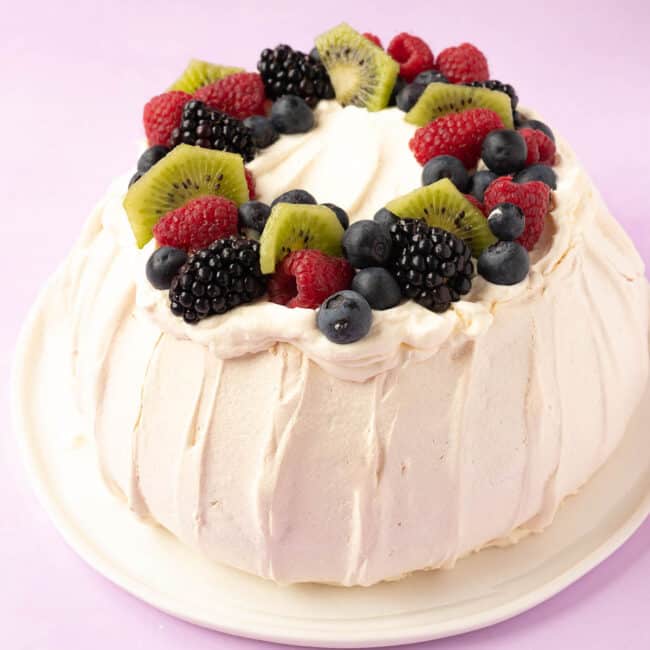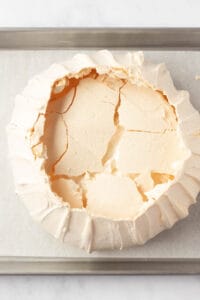A tall Pavlova decorated with whipped cream and fresh fruits.
Ingredients
- 6 large eggs, room temperature
- 300 grams (1 and 1/2 cups) caster sugar or very fine sugar
- 1 and 1/2 teaspoons white vinegar
- 1 teaspoon vanilla extract
- 500 ml (2 cups) thickened or heavy cream, to decorate
- Fresh fruits or berries, to decorate
Instructions
- Preheat oven to 120 C (250 F) standard / 110 C (230 F) fan-forced. Line a large aluminum baking tray with non-stick baking or parchment paper. Ensure your mixing bowl and utensils are clean and completely dry.
- Separate your eggs very carefully, ensuring there are NO egg yolks in your egg whites.You won’t need the egg yolks for this recipe.
- Use a stand mixer fitted with a whisk attachment to start beating the egg whites on medium speed until they reach soft peaks – approximately 1-2 minutes.
- Turn the mixer up to medium-high speed. Gradually add sugar, 1 tablespoon at a time, while continuing to beat the egg whites.
- Continue until you have added all the sugar. Keep mixing until all the sugar has dissolved and the meringue reaches stiff peaks. It should be thick, white and glossy. The easiest way to tell if your meringue is ready is by rubbing a small bit of meringue between your finger and thumb and seeing if you can still feel any sugar granules. If you can, keep mixing. As soon as it’s smooth and you cannot feel any sugar, stop mixing.
- Finally, add vinegar and vanilla to meringue mixture and beat on medium-high for 1 minute.
- Transfer meringue to prepared tray and use a small spatula or palette knife to shape the meringue into a 6-inch circle, keeping it as tall as possible.
- Then, use the knife to pull upwards to make long strokes all the way around the edges. This will help provide the meringue with more stability.
- Bake meringue for approximately 1 and 1/2 hours or until it is lightly golden, crisp, and hollow sounding when lightly tapped. Turn the oven off and leave the Pavlova in the oven to cool completely, with the door ajar.
- To decorate, carefully use a small sharp knife to cut a circle out of the top of the Pavlova. The crust on top will crumble into pieces revealing the marshmallow middle underneath. Carefully lay the crust back on top of the marshmallow meringue. See photo below for guidance.
- Place cream in a large mixing bowl. Use an electric mixer fitted with a whisk attachment and start beating on a medium speed.
- Continue to mix and watch closely as the cream changes texture. Instead of going by time, look for visual clues. Your cream will slowly thicken and become smooth, creamy, and cloud-like.
- Dollop cream all over the top of the meringue. Carefully arrange fresh fruits and berries on top of the cream. Serve immediately.
Notes
Egg whites: Be very careful when separating your eggs. Even if a speck of egg yolk lands in your egg whites, your meringue won’t whip up correctly and you’ll need to start again.
Caster sugar: You need to ensure your sugar is completely dissolved before baking your meringue. The easiest way to test this is by rubbing a small amount of meringue between your forefinger and thumb and seeing if you can feel any granules of sugar. If you can, keep mixing. As soon as you can’t, stop mixing. My Mother-in-law even checks the meringue after each spoonful of sugar is added, to ensure the sugar is dissolved before adding the next.
Fruits and berries: You can really use any fresh fruit or berries you like to decorate your Palova. Helen’s favourite toppings include raspberries, blueberries, blackberries, strawberries and sliced kiwi fruit.
Baking and cooling: It’s very important to let Pavlova slowly, so leave it in the oven (turned off) with the door slightly ajar for hours until it is completely cooled.
Making ahead: If you are making it the day before serving, you can even shut the oven door (once it’s completely cooled) and leave the Pavlova in there overnight. Alternatively, loosely cover with baking paper and leave it at room temperature. Do not put it in the fridge.
Cracking: Pavlovas are prone to cracking, so rest assured this is very normal. Even a perfect Pavlova will have a few minor cracks here and there. However, if your meringue cracks so much it’s at the point of collapsing, it might be a sign that your oven temperature was too high and/or your egg whites were whipped too quickly – try lowering the speed of your mixer next time. If your meringue was under-baked, it could also mean it’s extra fragile.
Weeping: There are a few common reasons why Pavlovas can weep once cooled. It could be a sign your sugar was not completely dissolved before baking and/or a result of under-baking your meringue. It could also mean your Pavlova has been affected by the weather and the humidity.


